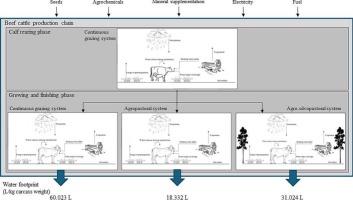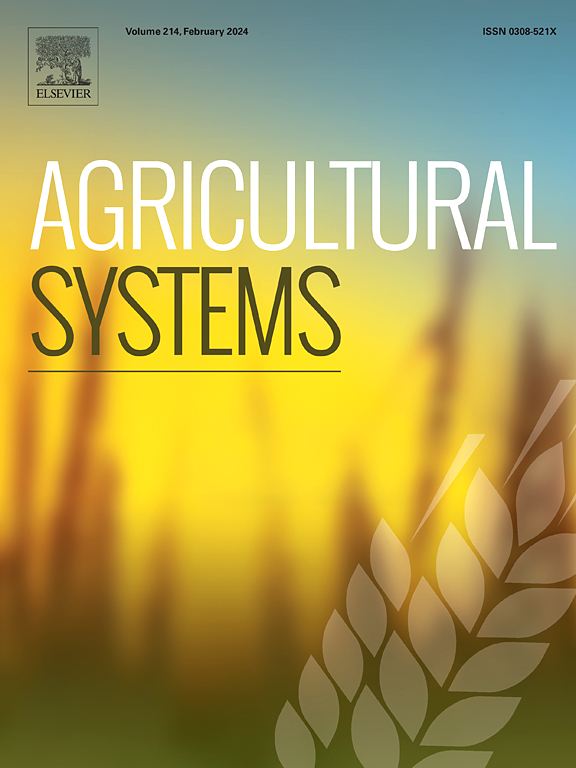减少热带地区放牧型牛肉生产系统水足迹的途径
IF 6.1
1区 农林科学
Q1 AGRICULTURE, MULTIDISCIPLINARY
引用次数: 0
摘要
背景水的可用性决定了农业用地的使用模式,而农业用地的使用模式又反过来影响水的供应。肉牛生产是耗水量最大的食品生产活动之一。因此,最重要的是找到减少水消耗的途径,并确定合适的生产区域,以减轻目前对水资源的压力。目标我们的目标是评估不同土地利用系统中肉牛的水足迹,并调查替代生产策略的潜力,以减少与水资源利用相关的环境影响。方法采用生命周期评估方法,对传统牧场系统(CON)、农牧系统(ICL)和农硅牧系统(ICLF)生产的牛肉的水足迹进行了从 "摇篮 "到 "农场 "的分析,其中包括对巴西塞拉多地区降雨耗水对环境影响的补充分析、结果与结论提高系统效率(如提高饲料转化效率、提高放养率、降低动物屠宰年龄等)使 ICL(18332 升和 1526 升/千克胴体重)的水足迹和缺水足迹低于 CON(60023 升和 2446 升/千克胴体重),其次是 ICLF(31024 升和 1846 升/千克胴体重)。降雨耗水量(即绿色缺水)对 ICL 的影响最小(182-328 升世界当量/千克胴体重)。虽然 ICLF 系统中树木的存在会限制生产率,但它改善了热环境以及牧草的冠层结构和营养价值,从而与 CON 系统相比减少了水足迹指标。在水足迹研究中,不应忽视降雨消耗的水对环境的影响,因为这对恢复水循环非常重要,而这在土地利用多样化(如 ICL 和 ICLF)中尤为复杂。总之,ICL 和 ICLF 是减少放牧系统耗水量对环境影响的可行生产策略。 意义这项研究是在巴西塞拉多地区进行的,该地区是世界上肉牛生产和出口的主要地区,也是水资源动态中具有重要战略意义的生物群落。该地区面临着巨大的水资源消耗挑战,因为农业的加速发展与水资源利用的长期规划和监测脱节。因此,我们的研究结果对于支持生态系统的恢复能力和牛肉生产至关重要,同时还能深入了解农牧业和农-丝-牧系统用水对环境的影响,而科学文献中对这些系统的介绍并不多。本文章由计算机程序翻译,如有差异,请以英文原文为准。

A pathway for decreasing the water footprint from grazing-based beef production systems in the Tropics
CONTEXT
Water availability shapes agricultural land use patterns, which in turn impacts water supplies. Beef cattle production is one of the most water-intensive food production activities. Therefore, it is fundamental to identify pathways to reduce water consumption and to determine suitable producing-regions to mitigate the current pressures on water resources.
OBJECTIVE
Our objectives were to assess the water footprint of beef cattle in different land use systems and investigate the potential of alternative production strategies to reduce the environmental impacts associated with water resources use.
METHODS
The water footprint of beef produced in conventional pasture system (CON), agropastoral (ICL), and agro-silvopastoral (ICLF) systems was analysed from cradle-to-farm gate using a life cycle assessment approach, which included a complementary analysis of the environmental impacts of the rainfall water consumption in the Brazilian Cerrado.
RESULTS AND CONCLUSIONS
Increases in the efficiency of the systems (e.g., greater feed conversion efficiency, stocking rates, reduced slaughter age of animals, amongst others) resulted in a lower water footprint and water scarcity footprint in ICL (18,332 L and 1526 L/kg carcass weight), followed by ICLF (31,024 L and 1846 L/kg carcass weight) compared to CON (60,023 L and 2446 L/kg carcass weight). The impact of rainfall water consumption (i.e., green water scarcity) was lowest in ICL (182–328 Lworld equivalents/kg carcass weight). Although the tree presence in ICLF systems can limit the productivity, it improves the thermal environment as well as the canopy structure and nutritional value of forage on pastures for grazing animals, thereby reducing the water footprint indicators compared to CON systems. The environmental impacts of rainfall water consumed should not be neglected in water footprint studies due to its importance for restoring water cycles, which is particularly complex in diversified land uses, such as ICL and ICLF. In conclusion, ICL and ICLF are viable production strategies for reducing the environmental impacts of water consumption in grazing-based systems.
SIGNIFICANCE
The research was carried out in the Brazilian Cerrado, a major region for producing and exporting beef cattle in the world and a biome of strategic importance in the water resources dynamics. The region faces significant water consumption challenges because of the accelerated agricultural development disassociated from long-term planning and monitoring of its water resources use. Therefore, our findings are critical in supporting ecosystem resilience and production of beef by also providing insights into the environmental impacts of water consumption in agropastoral and agro-silvopastoral systems, which have been underrepresented in scientific literature.
求助全文
通过发布文献求助,成功后即可免费获取论文全文。
去求助
来源期刊

Agricultural Systems
农林科学-农业综合
CiteScore
13.30
自引率
7.60%
发文量
174
审稿时长
30 days
期刊介绍:
Agricultural Systems is an international journal that deals with interactions - among the components of agricultural systems, among hierarchical levels of agricultural systems, between agricultural and other land use systems, and between agricultural systems and their natural, social and economic environments.
The scope includes the development and application of systems analysis methodologies in the following areas:
Systems approaches in the sustainable intensification of agriculture; pathways for sustainable intensification; crop-livestock integration; farm-level resource allocation; quantification of benefits and trade-offs at farm to landscape levels; integrative, participatory and dynamic modelling approaches for qualitative and quantitative assessments of agricultural systems and decision making;
The interactions between agricultural and non-agricultural landscapes; the multiple services of agricultural systems; food security and the environment;
Global change and adaptation science; transformational adaptations as driven by changes in climate, policy, values and attitudes influencing the design of farming systems;
Development and application of farming systems design tools and methods for impact, scenario and case study analysis; managing the complexities of dynamic agricultural systems; innovation systems and multi stakeholder arrangements that support or promote change and (or) inform policy decisions.
 求助内容:
求助内容: 应助结果提醒方式:
应助结果提醒方式:


